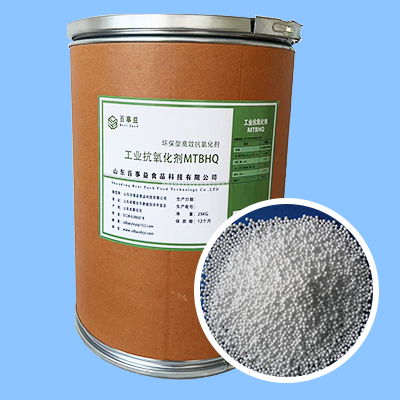Monomer polymerization polymerization inhibitor
a shows the chemical structure of 2,5-Di-tert-butyl-hydroquinone (2,5-DTBHQ). It is a very effective inhibitor (antioxidant) for styrene polymerization and therefore is extensively utilized in industry. Antioxidants usually function in the presence of oxygen and terminate the reaction chain by supplying hydrogen atoms to alleviate peroxyl radicals . The bond dissociation energies (BDE) of O-H bond in 2,5-DTBHQ and 2,5-di-tert-butyl semiquinone are 81.2 and 59.1 kcal/mol, respectively. Due to these low BDEs, hydroquinones are very reactive towards peroxyl radicals.
Possible reaction pathways of 2,5-di-tert-butyl-hydroquinone (2,5-DTBHQ).
Valgimigli et al. proposed a mechanism wherein semiquinone (2) reacts with molecular oxygen to produce 2,5-di-tert-butyl-1,4-benzoquinone (2,5-DTBBQ) and hydroperoxyl radical (HOO∙). The semiquinone (2) terminates a second propagation chain via either hydrogen abstraction (Reaction II) or addition reaction (Reaction IV) and these reaction pathways play a very critical role in the inhibition process. The semiquinone can also quickly disproportionate to 2,5-di-tert-butyl-1,4-benzoquinone (2,5-DTBBQ) (3) and 2,5-DTBHQ through the pathway of Reaction V without any quenching with the peroxyl radical. Through Reaction V, semiquinone regenerates 2,5-DTBHQ which can further react in the system. There is another probability, in which the additional reaction of semiquinone (2) with another peroxyl radical is also possible (Reaction VII).
shows the dilatometry trace of 4.5 mM solution of 2,5-DTBHQ in styrene being analyzed at 110 °C for 4 h to inhibit the thermal styrene polymerization. It is evident from the figure that the inhibition time of styrene polymerization by 2,5-DTBHQ is 36 min, which is in fact worse taking into account the high concentration of the inhibitor. It can be assumed that 2,5-DTBHQ ceases to work in the absence of oxygen and the inhibition time is basically the time taken by the reaction system to become deoxygenated. Thus, the dilatometry trace concludes that 2,5-DTBHQ exhibits an inhibition property only in the oxygenated environment and its efficacy owes to the termination of the propagation chains via hydrogen abstraction. The inhibition phase is then followed by a duration of a little retardation of the styrene polymerization by 2,5-DTBHQ, which can be inferred from in which the slope of the dilatometry trace is smaller as compared to that of polymerization in the absence of the 2,5-DTBHQ inhibitor. More specifically, the formed 2,5-DTBBQ may react with the carbon-centered radicals via the addition reaction and terminate some propagating chains .








